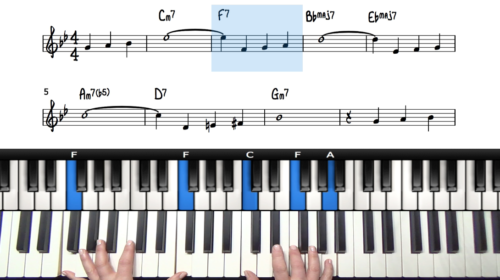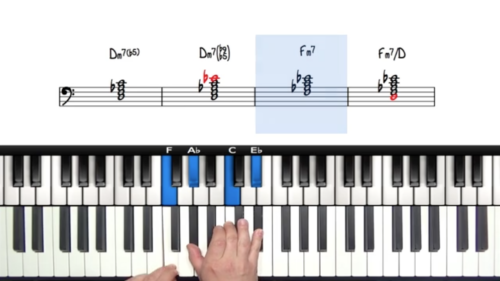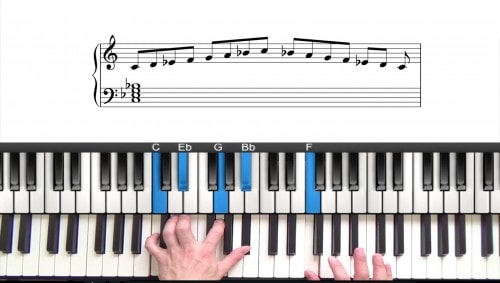Minor Line Cliche Tutorial
In this lesson you will learn how to arrange minor chords like a pro.
The minor line cliche is a very common progression jazz music. You will find this chord sequence in countless jazz standards so it makes sense to understand how the progression is constructed.
We will explore the different ways we can navigate over the minor line cliche using bass lines, two-handed chords and inner voices,
One thing is for certain, after this lesson you will always have something to play over the minor line cliche.
Lesson Downloads
-
Minor Chord Progressions Notation File Type: pdf
Practice Tips
-
Remember that the movement in the minor line cliche can be used over any minor chord.
-
If you are sitting on a minor chord for an extended period of time, or if you simply want to add some additional movement, the minor line cliche is always a tool in your arsenal.
-
Moving the voice from minor 7th to major 7th is very subtle but also very effective. Next time you see a minor chord on a lead sheet... test it out.








Another practical and easy to understand video!Can you Mark me an exemple of whole step minor line cliche movement please?I cant see any exemple on the vídeo.Thkns hayden
Hi Ivan,
Check out these lessons:
Inner Voice Movement: pianogroove.com/jazz-piano-lessons/adding-inner-voice-movement/
WAYDTROYL: pianogroove.com/jazz-piano-lessons/what-are-you-doing-the-rest-of-your-life-tutorial/
Cheers!
Hayden
I note that on minor chords you often us 1-5 instead of a 1-7 in the left hand. I was taught that a 1-5 in the left tends to stabilize a minor chord which is unstable. Same with dominants. Your thoughts. Thanks, ECE
Hi Edwin,
Great question!
The root and 5th is a unique interval because it can be played way down in the lower registers of the piano without sounding too ‘muddy’.
If we take other intervals such as 3rds, 6ths, or 7ths, and play them in the lower registers we will hear that the sound often becomes distorted.
This makes the 5th a useful interval to play in our left hand to add more ‘weight’ and ‘impact’ to our voicings. Often when the left hand and is playing a 5th interval, the right hand will be playing the 3rd and 7th of the chord which is important to establish the harmonic quality of the chord (major, minor, or dominant).
I wouldn’t say that a minor chord is ‘unstable’, however by playing the root and 5th in our left hand, and the other notes of the minor chord in our right hand, we create a bigger, meatier sound.
The same applies to major chords and to some extend dominant chords. The only area to be careful of with dominant chords is that sometimes we may voice the #5/b13 in our right hand – see our upcoming course on chord alterations here: pianogroove.com/jazz-piano-lessons/altered-harmony-upper-structure-triads/
If we are playing the #5/b13 colour in our right hand for a dominant chord, then we would want to avoid the natural 5th in our left hand as this would clash.
I hope that helps to answer your question, any other questions here just let me know.
Cheers,
Hayden
Hi. I see at the start of each standard you play the melody with a really nice arrangement like a solo piano style, with root notes, and a few other tools mentioned above. Is there a tutorial on how to play standards such as this for solo piano using techniques used here?
Hi Sudeep,
Yes you can find a full list of jazz standards that we cover here: pianogroove.com/jazz-standards/
Each one of our courses has a section called “Jazz Standard Studies” where we apply the theory in practice. For example, scroll down on the course page where this lesson exists: pianogroove.com/jazz-piano-lessons/left-hand-voicings/ – and you will see the jazz standard applications. This is the same for all courses on the site.
Hope that helps and let me know if I can be of further assistance.
Cheers,
Hayden
Not really a question on anything important – but on the Course Info intro to this course, you’ve got My Funny Valentine as a Victor Young song, and it’s Rodgers and Hart (as is Have You Met Miss Jones), and I feel the need to stick up for my favorite song
writing team. :)
What song is this? It’s beautiful
Hi Brendan,
Thanks for the comment, it’s also one of my favourite tunes.
The tune is called “In A Sentimental Mood” which is one of Duke Ellington’s most famous compositions.
We actually have a lot of lessons on this tune, here are the links:
All lessons in this minor harmony and improv course focus on this tune: pianogroove.com/jazz-piano-lessons/minor-harmony-improvisation/
Here is a 2 part jazz standard lesson:
pianogroove.com/jazz-piano-lessons/sentimental-mood-tutorial/
pianogroove.com/jazz-piano-lessons/sentimental-mood-tutorial-part-2/
And finally here is a lesson which explores the ascending melodic motif and how it can be harmonised:
pianogroove.com/jazz-piano-lessons/harmonising-step-wise-melodies/
Let me know if I can help further and enjoy the lessons!
Cheers,
Hayden
Great thanks Hayden